Carbon Dioxide Utilization Using Chlorella Microalgae
Abstract
:1. Introduction
2. Materials and Methods
3. Results
4. Conclusions
Author Contributions
Funding
Data Availability Statement
Conflicts of Interest
References
- Sumida, K.; Rogow, D.L.; Mason, J.A.; McDonald, T.M.; Bloch, E.D.; Herm, Z.R.; Bae, T.-H.; Long, J.R. Carbon dioxide capture in metal-organic frameworks. Chem. Rev. 2012, 112, 724–781. [Google Scholar] [PubMed]
- Zhang, S.; Liu, Z. Advances in the biological fixation of carbon dioxide by microalgae. J. Chem. Technol. Biotechnol. 2021, 96, 1475–1495. [Google Scholar] [CrossRef]
- Wang, X.; Song, C. Carbon Capture From Flue Gas and the Atmosphere: A Perspective. Front. Energy Res. 2020, 8, 1–24. [Google Scholar] [CrossRef]
- United States Energy Information Administration, Department of Energy. Emissions of Greenhouses Gases in the United States 1996. DOE/EIA-0573(96). Available online: https://digital.library.unt.edu/ark:/67531/metadc697717/?q=%22United%20States%22 (accessed on 15 November 2022).
- Yamasaki, A. An overview of CO2 mitigation options for global warmingemphasizing CO2 sequestration options. J. Chem. Eng. Jpn. 2003, 36, 361–375. [Google Scholar] [CrossRef]
- Coyle, W.A. Global Perspective: The Future of Biofuels. 2007. Available online: https://naldc.nal.usda.gov/download/10246/PDF (accessed on 23 December 2022).
- Toebelmann, D. The impact of environmental innovation on carbon dioxide emissions. J. Clean. Prod. 2020, 244, 118787. [Google Scholar] [CrossRef]
- Crofcheck, C.; Monstross, M.; Xinyi, E.; Shea, A.; Crocker, M.; Andrews, R. Influence of media composition on the growth rate of chlorella vulgaris and scenedesmus acutus utilized for CO2 mitigation. Am. Soc. Agric. Biol. Eng. Annu. Int. Meet. 2012, 1, 532–549. [Google Scholar]
- Zhao, B.; Su, Y. Process effect of microalgal-carbon dioxide fixation and biomass production: A review. Renew. Sustain. Energy 2014, 31, 121–132. [Google Scholar] [CrossRef]
- Koh, M.-H. CO2 Capture, Utilization, and Storage (CCUS) Policy Trends in the European Union (EU) and Major European Countries. Korean Public Land Law Assoc. 2022, 100, 463–483. [Google Scholar] [CrossRef]
- Huang, L.; Hou, Z.; Fang, Y.; Liu, J.; Shi, T. Evolution of CCUS Technologies Using LDA Topic Model and Derwent Patent Data. Evolution of CCUS Technologies Using LDA Topic Model and Derwent Patent Data. Energies 2023, 16, 2556. [Google Scholar] [CrossRef]
- IEA. Energy Technology Perspectives 2020. Available online: https://www.iea.org/reports/energy-technology-perspectives-2020 (accessed on 5 January 2023).
- Hills, C.D.; Tripathi, N.; Carey, P.J. Mineralization technology for carbon capture, utilization, and storage. Front. Energy Res. 2020, 8, 142. [Google Scholar] [CrossRef]
- Xiong, Y.; Hou, Z.; Xie, H.; Zhao, J.; Tan, X.; Luo, J. Microbial-mediated CO2 methanation and renewable natural gas storage in depleted petroleum reservoirs: A review of biogeochemical mechanism and perspective. Gondwana Res. 2022, in press. [Google Scholar]
- Luo, J.; Hou, Z.; Feng, G.; Liao, J.; Haris, M.; Xiong, Y. Effect of Reservoir Heterogeneity on CO2 Flooding in Tight Oil Reservoirs. Energies 2022, 15, 3015. [Google Scholar] [CrossRef]
- Nocito, F.; Dibenedetto, A. Atmospheric CO2 mitigation technologies: Carbon capture utilization and storage. Curr. Opin. Green Sustain. Chem. 2020, 21, 34–43. [Google Scholar] [CrossRef]
- Ahmed, D.S.; El-Hiti, G.A.; Yousif, E.; Ali, A.A.; Hameed, A.S. Design and synthesis of porous polymeric materials and their applications in gas capture and storage: A review. J. Polym. Res. 2018, 25, 75. [Google Scholar] [CrossRef]
- Ali, S.A.; Shah, S.N.; Shah, M.U.H.; Younas, M. Synthesis and performance evaluation of copper and magnesium-based metal organic framework supported ionic liquid membrane for CO2/N2 separation. Chemosphere 2023, 311, 136913. [Google Scholar] [CrossRef] [PubMed]
- Wang, M.; Lawal, A.; Stephenson, P.; Sidders, J.; Ramshaw, C. Post-combustion CO2 capture with chemical absorption: A state-of-the-art review. Chem. Eng. Res. Des. 2011, 89, 1609–1624. [Google Scholar] [CrossRef] [Green Version]
- Olajire, A.A. CO2 capture and separation technologies for end-of-pipe applications e a review. Energy 2010, 35, 2610–2627. [Google Scholar]
- Song, C.; Liu, Q.; Deng, S.; Li, H.; Kitamura, Y. Cryogenic-based CO2 capture technologies: State-of-the-art developments and current challenges. Renew. Sustain. Energy Rev. 2019, 101, 265–278. [Google Scholar] [CrossRef]
- Assis, T.C.; Calijuri, M.L.; Assemany, P.P.; Pereira, A.S.A.P.; Martins, M.A. Using atmospheric emissions as CO2 source in the cultivation of microalgae: Productivity and economic viability. J. Clean. Prod. 2019, 215, 1160–1169. [Google Scholar] [CrossRef]
- Xu, X.; Gu, X.; Wang, Z.; Shatner, W.; Wang, Z. Progress, challenges and solutions of research on photosynthetic carbon sequestration efficiency of microalgae. Renew. Sustain. Energy Rev. 2019, 101, 65–82. [Google Scholar] [CrossRef]
- Zhang, Q.; Wang, Y.; Liu, L. Carbon Tax or Low-Carbon Subsidy? Carbon Reduction Policy Options under CCUS Investment. Sustainability 2023, 15, 5301. [Google Scholar] [CrossRef]
- Iasimone, F.; De Felice, V.; Panico, A.; Pirozzi, F. Experimental study for the reduction of CO2 emissions in wastewater treatment plant using microalgal cultivation. J. CO2 Utiliz. 2017, 22, 1–8. [Google Scholar] [CrossRef]
- Molazadeh, M.; Ahmadzadeh, H.; Pourianfar, H.R.; Lyon, S.; Rampelotto, P.H. The Use of Microalgae for Coupling Wastewater Treatment With CO2 Biofixation. Front. Bioeng. Biotechnol. 2019, 7, 42. [Google Scholar] [CrossRef] [PubMed] [Green Version]
- Daneshvar, E.; Wicker, R.J.; Show, P.-L.; Bhatnagar, A. Biologically-mediated carbon capture and utilization by microalgae towards sustainable CO2 biofxation and biomass valorization—A review. Chem. Eng. J. 2022, 427, 130884. [Google Scholar] [CrossRef]
- Herzog, H.; Golomb, D. Carbon capture and storage from fossil fuel use. Encycl. Energy 2004, 1, 1–11. [Google Scholar] [CrossRef]
- Wang, B.; Li, Y.; Wu, N.; Lan, C.Q. CO2 bio-mitigation using microalgae. Appl. Microbiol. Biotechnol. 2008, 79, 65–82. [Google Scholar] [CrossRef]
- Rawat, R.I.; Ranjith Kumar, R.; Mutanda, T.; Bux, F. Biodiesel from Microalgae: A Critical Evaluation from Laboratory to Large Scale Production. Appl. Energy 2013, 103, 444–467. [Google Scholar] [CrossRef]
- Wang, B.; Li, Y.; Wu, N.; Lan, C.Q. CO2 Bio-Mitigation Using Microalgae. Appl. Microbiol. Biotechnol. 2008, 79, 707–718. [Google Scholar] [CrossRef]
- Demirbas, A. Current Technologies for the Thermo-Conversion of Biomass into Fuels and Chemicals. Energy Sources 2004, 26, 715–730. [Google Scholar] [CrossRef]
- Razzak, S.A.; Hossain, M.M.; Lucky, R.A.; Bassi, A.S.; de Lasa, H.I. Integrated CO2 Capture, Wastewater Treatment and Biofuel Production by Microalgae Culturing. Renew. Sustain. Energy Rev. 2013, 27, 622–653. [Google Scholar] [CrossRef]
- Wang, S.K.; Stiles, A.R.; Guo, C.; Liu, C.Z. Microalgae Cultivation in Photobioreactors: An Overview of Light Characteristics. Eng. Life Sci. 2014, 14, 550–559. [Google Scholar] [CrossRef] [Green Version]
- Chauvy, R.; Meunier, N.; Thomas, D.; De Weireld, G. Selecting emerging CO2 utilization products for short- to mid-term deployment. Appl. Energy 2019, 236, 662–680. [Google Scholar] [CrossRef]
- Lam, M.K.; Lee, K.T.; Mohamed, A.R. Current status and challenges on microalgae-based carbon capture. Int. J. Greenh. Gas Con. 2012, 10, 456–469. [Google Scholar] [CrossRef]
- Mallapragada, D.S.; Singh, N.R.; Curteanu, V.; Agrawal, R. Sun-to-fuel assessment of routes for fixing CO2 as liquid fuel. Ind. Eng. Chem. Res. 2013, 52, 5136–5144. [Google Scholar] [CrossRef]
- Thomas, D.M.; Mechery, J.; Paulose, S.V. Carbon dioxide capture strategies from flue gas using microalgae: A review. Environ. Sci. Pollut. Res. 2016, 23, 16926–16940. [Google Scholar] [CrossRef] [PubMed]
- Kadam, K.L. Power Plant Fuel as a Source of CO2 for Microalgae Cultivation: Economic Impact of Different Process Options. Energy Convers. Manag. 1997, 38, 505–510. [Google Scholar] [CrossRef]
- Watanabe, Y.; Saiki, H. Development of a photobioreactor incorporating Chlorella sp. for removal of CO2 in stack gas. Energy Convers. Manag. 1997, 38, 499–503. [Google Scholar] [CrossRef]
- Benemann, J. CO2 mitigation with microalgae systems. Energy Convers. Manag. 1997, 38, 475–479. [Google Scholar] [CrossRef]
- Singh, U.B.; Ahluwalia, A.S. Microalgae: A promising tool for carbon sequestration. Mitig. Adapt. Strat. Glob. Change 2013, 18, 73–95. [Google Scholar] [CrossRef]
- Singh, S.K.; Sundaram, S.; Sinha, S.; Rahman, M.A.; Kapur, S. Recent Advances in CO2 Uptake and Fixation Mechanism of Cyanobacteria and Microalgae. Crit. Rev. Environ. Sci. Technol. 2016, 46, 1297–1323. [Google Scholar] [CrossRef]
- Li, G.; Xiao, W.; Yang, T.; Lyu, T. Optimization and Process Effect for Microalgae Carbon Dioxide Fixation Technology Applications Based on Carbon Capture: A Comprehensive Review. C 2023, 9, 35. [Google Scholar] [CrossRef]
- Prasad, R.; Gupta, S.K.; Shabnam, N.; Oliveira, C.Y.B.; Nema, A.K.; Ansari, F.A.; Bux, F. Role of Microalgae in Global CO2 Sequestration: Physiological Mechanism, Recent Development, Challenges, and Future Prospective. Sustainability 2021, 13, 13061. [Google Scholar] [CrossRef]
- Li, Y.; Horsman, M.; Wu, N.; Lan, C.Q.; Dubois-Calero, N. Biofuels from microalgae. Biotechnol. Prog. 2008, 24, 815–820. [Google Scholar] [CrossRef]
- Thiruvenkatachari, R.; Su, S.; An, H.; Yu, X.X. Post combustion CO2 capture by carbon fibre monolithic adsorbents. Prog. Energy Combust. Sci. 1997, 35, 438–455. [Google Scholar] [CrossRef]
- Meisen, A.; Shuai, X. Research and development issues in CO2 capture. Energy Convers. Manage. 1997, 38, S37–S42. [Google Scholar] [CrossRef]
- Erga, O.; Juliussen, O.; Lidal, H. Carbon dioxide recovery by means of aqueous amines. Energy Convers. Manage. 1995, 36, 387–392. [Google Scholar] [CrossRef]
- Ismail, D. Utilization of chlorella vulgaris to fixate a high concentration of carbon dioxide in a compost-based medium. Int. J. Technol. 2016, 7, 168–175. [Google Scholar] [CrossRef]
- Chia, S.R.; Chew, K.W.; Leong, H.Y.; Ho, S.-H.; Munawaroh, H.S.H.; Show, P.L. CO2 mitigation and phycoremediation of industrial flue gas and wastewater via microalgae-bacteria consortium: Possibilities and challenges. Chem. Eng. J. 2021, 425, 131436. [Google Scholar] [CrossRef]
- Kulabukhov, V.; Karyakin, D.; Mal’tsevckaya, N. Prospects for the Use of Microalgae to Absorb CO2 from the Flue Gases of Industrial Enterprises. Ecol. Ind. Russ. 2016, 20, 4–8. (In Russian) [Google Scholar] [CrossRef]
- De Morais, M.G.; Costa, J.A.V. Isolation and selection of microalgae from coal fired thermoelectric power plant for biofixation of carbon dioxide. Energy Convers. Manag. 2007, 48, 2169–2173. [Google Scholar] [CrossRef]
- Song, C.; Liu, J.; Xie, M.; Qiu, Y.; Chen, G.; Qi, Y.; Kitamura, Y. Intensification of a novel absorption-microalgae hybrid CO2 utilization process via fed-batch mode optimization. Int. J. Greenh. Gas Control 2019, 82, 1–7. [Google Scholar] [CrossRef]
- Moreira, J.B.; Terra, A.L.M.; Costa, J.A.V.; Morais, M.G. Utilization of CO2 in semi-continuous cultivation of spirulina sp. and chlorella fusca and evaluation of biomass composition. Braz. J. Chem. Eng. 2016, 33, 691–698. [Google Scholar] [CrossRef] [Green Version]
- Song, C.; Qiu, Y.; Xie, M.; Liu, J.; Liu, Q.; Li, S.; Kansha, Y. Novel regeneration and utilization concept using rich chemical absorption solvent as a carbon source for microalgae biomass production. Ind. Eng. Chem. Res. 2019, 58, 11720–11727. [Google Scholar] [CrossRef]
- Ratomski, P.; Hawrot-Paw, M.; Koniuszy, A. Utilisation of CO2 from sodium bicarbonate to produce chlorella vulgaris biomass in tubular photobioreactors for biofuel purposes. Sustainability 2021, 13, 9118. [Google Scholar] [CrossRef]
- Cordoba-Perez, M.; De Lasa, H. CO2-derived carbon capture and photon absorption efficiency by microalgae in novel photoBioCREC. Ind. Eng. Chem. Res. 2020, 59, 14710–14716. [Google Scholar] [CrossRef]
- Maryshamya, A.; Rajasekar, T.; Rengasamy, R. Carbon sequestration potential of scenedesmus quadricauda (turpin) and evaluation on zebra fish (danio rerio). Aquac. Rep. 2019, 13, 100178. [Google Scholar] [CrossRef]
- Kong, W.; Shen, B.; Lyu, H.; Kong, J.; Ma, J.; Wang, Z.; Feng, S. Review on Carbon Dioxide Fixation Coupled with Nutrients Removal from Wastewater by Microalgae. J. Clean. Prod. 2021, 292, 125975. [Google Scholar]
- Barati, B.; Zeng, K.; Baeyens, J.; Wang, S.; Addy, M.; Gan, S.-Y.; Abomohra, A.E.-F. Recent progress in genetically modified microalgae for enhanced carbon dioxide sequestration. Biomass Bioenergy 2021, 145, 105927. [Google Scholar]
- Li, J.; Pan, K.; Tang, X.; Li, Y.; Zhu, B.; Zhao, Y. The molecular mechanisms of Chlorella sp. responding to high CO2: A study based on comparative transcriptome analysis between strains with high- and low-CO2 tolerance. Sci. Total Env. 2021, 763, 144185. [Google Scholar] [CrossRef]
- Politaeva, N.A.; Smyatskaya, Y.A.; Kuznetsova, T.A.; Olshanskaya, L.N.; Valiev, R.S. Cultivation and use of microalgae Chlorella and higher aquatic plants duckweed Lemna. Saratov Ts Nauka 2017, 125. Available online: https://search.rsl.ru/ru/record/01009542108 (accessed on 5 January 2023).
- Zibarev, N.V.; Politaeva, N.A.; Andrianova, M.Y. Use of microalgae Chlorella sorokiniana (Chlorellaceae, Chlorellales) for wastewater treatment in the brewing industry. Povolzhsky Ecol. J. 2021, 3, 262–271. [Google Scholar] [CrossRef]
- Sanda, V.; Nicolae, D.; Sever, S.; Lucia, I.; Daniela, S.; Ana, N.; Emil, S. Biological sequestration of carbon dioxide from thermal power plant emissions, by absorbtion in microalgal culture media. Rom. Biotechnol. Lett. 2009, 14, 4485–4500. [Google Scholar]
- Li, S.; Chang, H.; Zhang, S.; Ho, S.-H. Production of sustainable biofuels from microalgae with CO2 bio-sequestration and life cycle assessment. Environ. Res. 2023, 227, 115730. [Google Scholar] [CrossRef] [PubMed]
- Velmozhina, K.A.; Shinkevich, P.S. The use of microalgae Chlorella kessleri for the intensification of anaerobic digestion of food waste. In Proceedings of the Waste Processing Technologies with Obtaining New Products: Materials of the IV All-Russian Scientific and Practical Conference with International Participation, Kirov, Russia, 30 November 2022; Vyatka State University: Kirov, Russia, 2022; pp. 183–184. [Google Scholar]
- Chusov, A.; Maslikov, V.; Badenko, V.; Zhazhkov, V.; Molodtsov, D.; Pavlushkina, Y. Biogas potential assessment of the composite mixture from duckweed biomass. Sustainability 2022, 14, 351. [Google Scholar] [CrossRef]

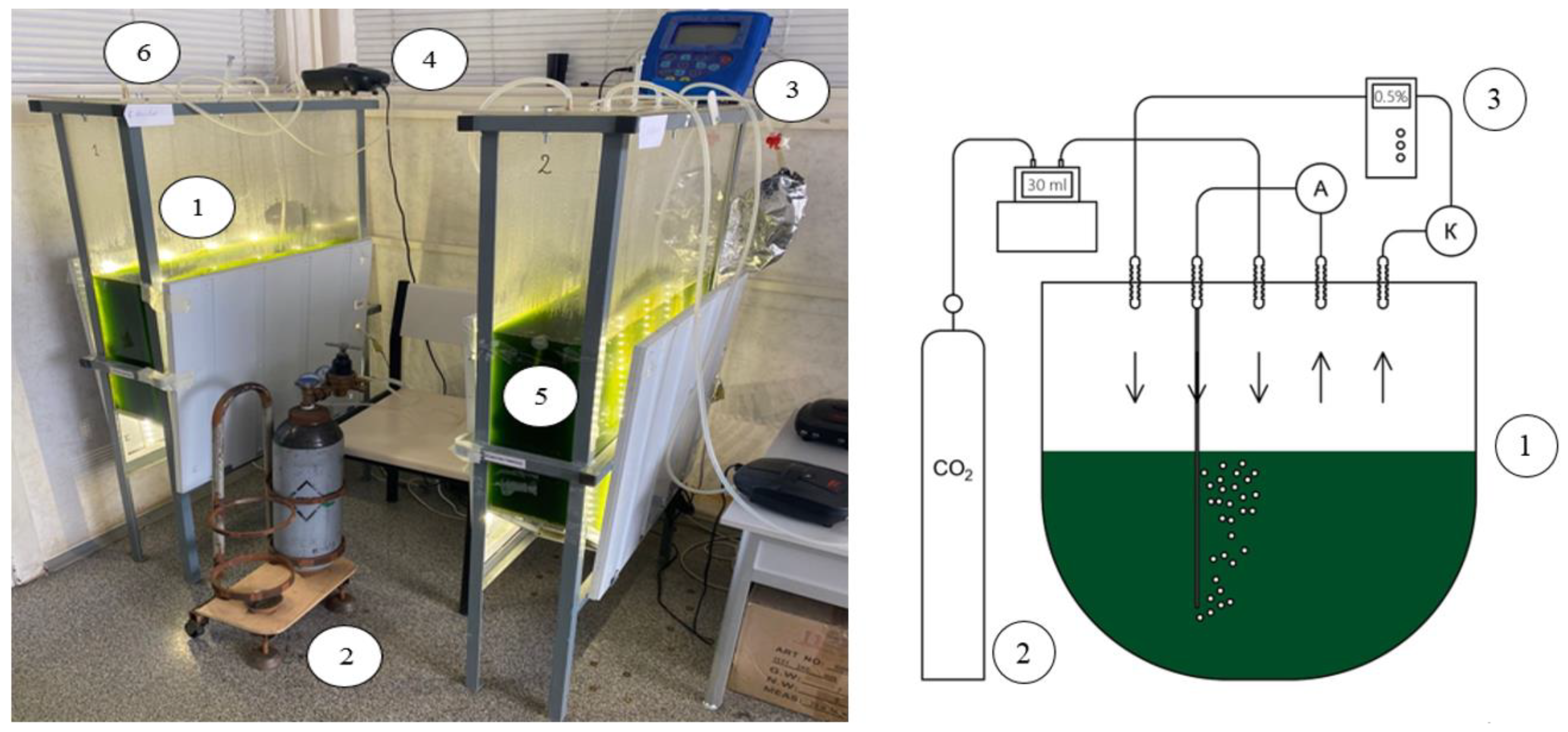
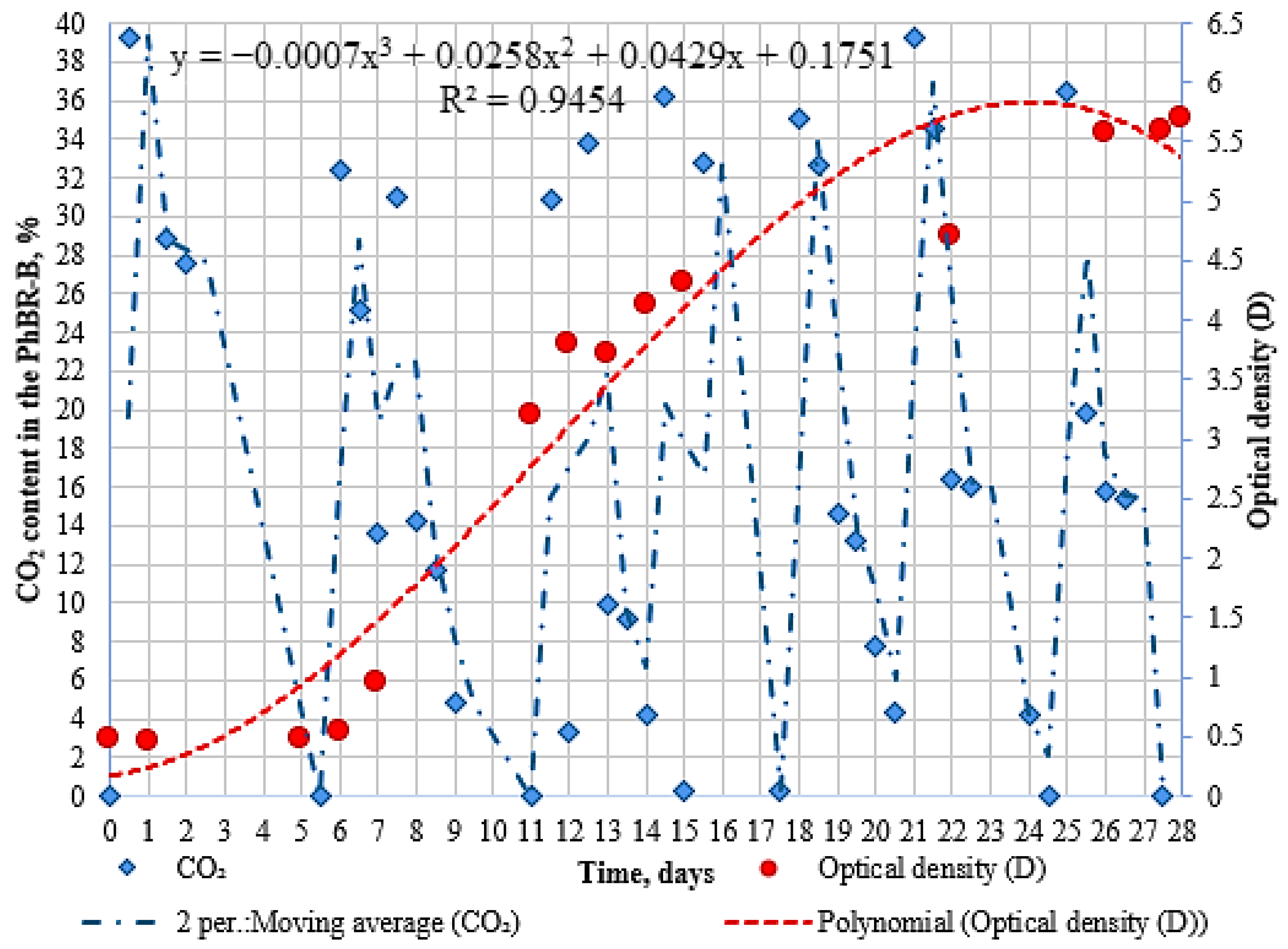
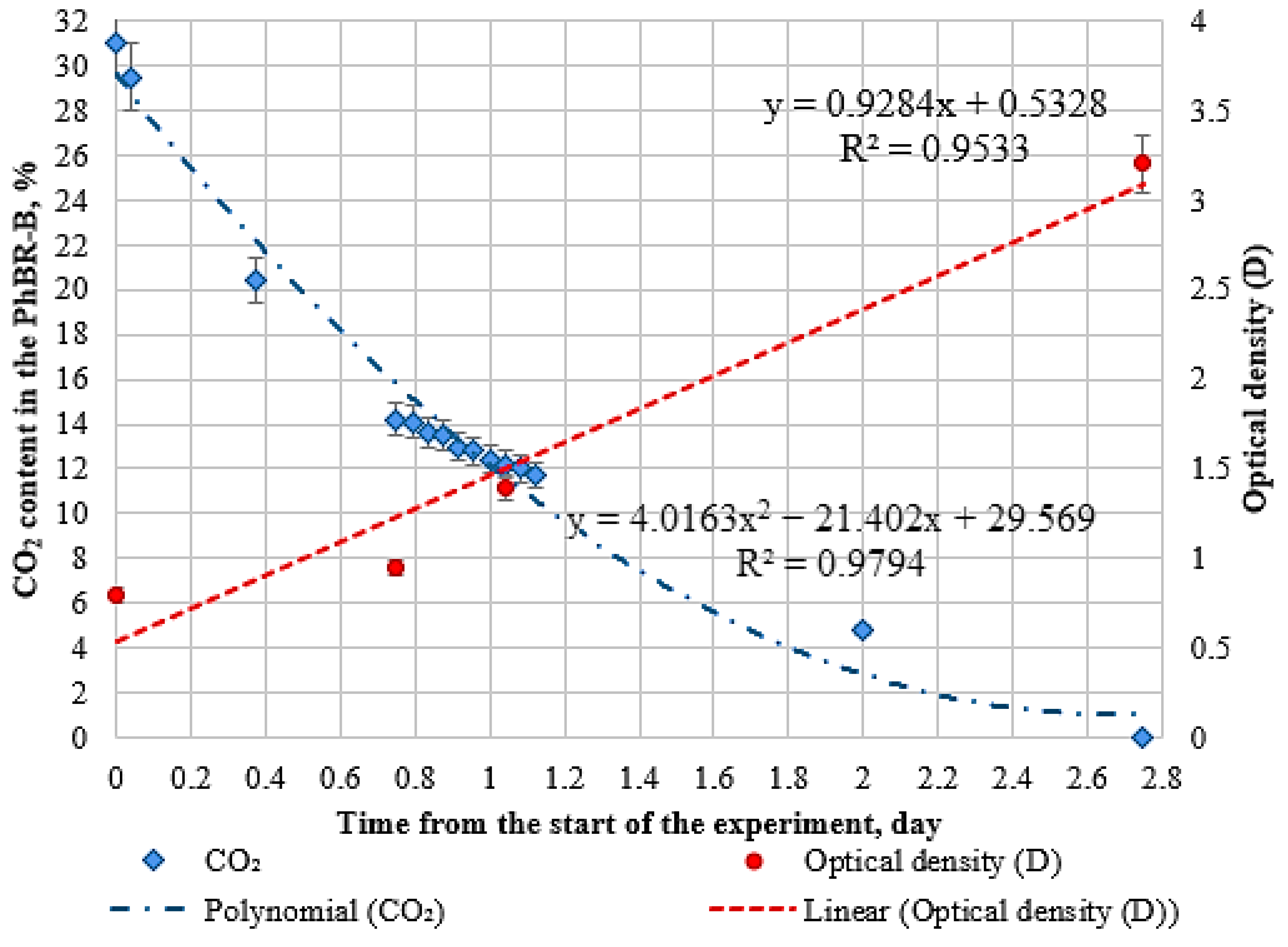
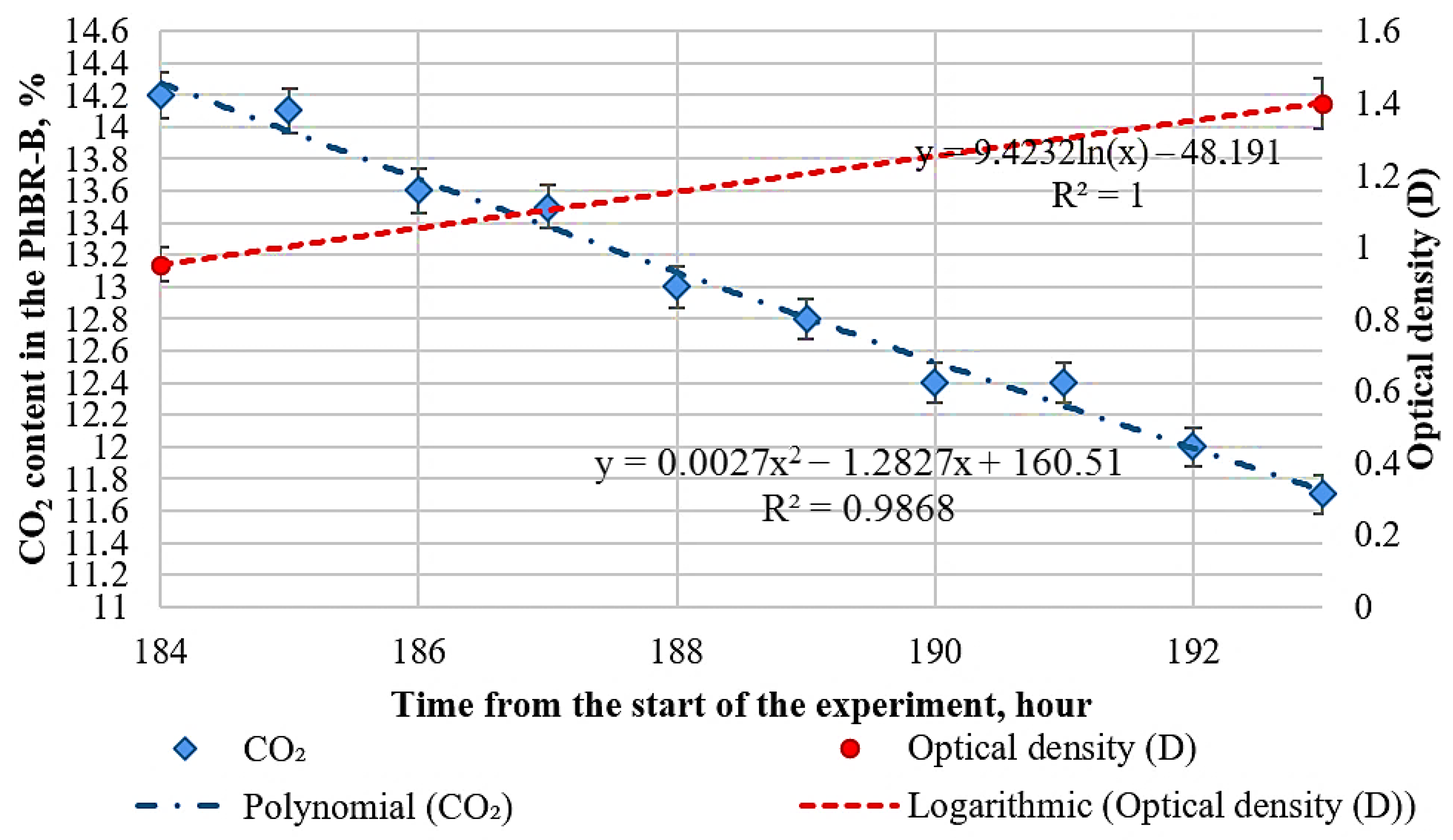
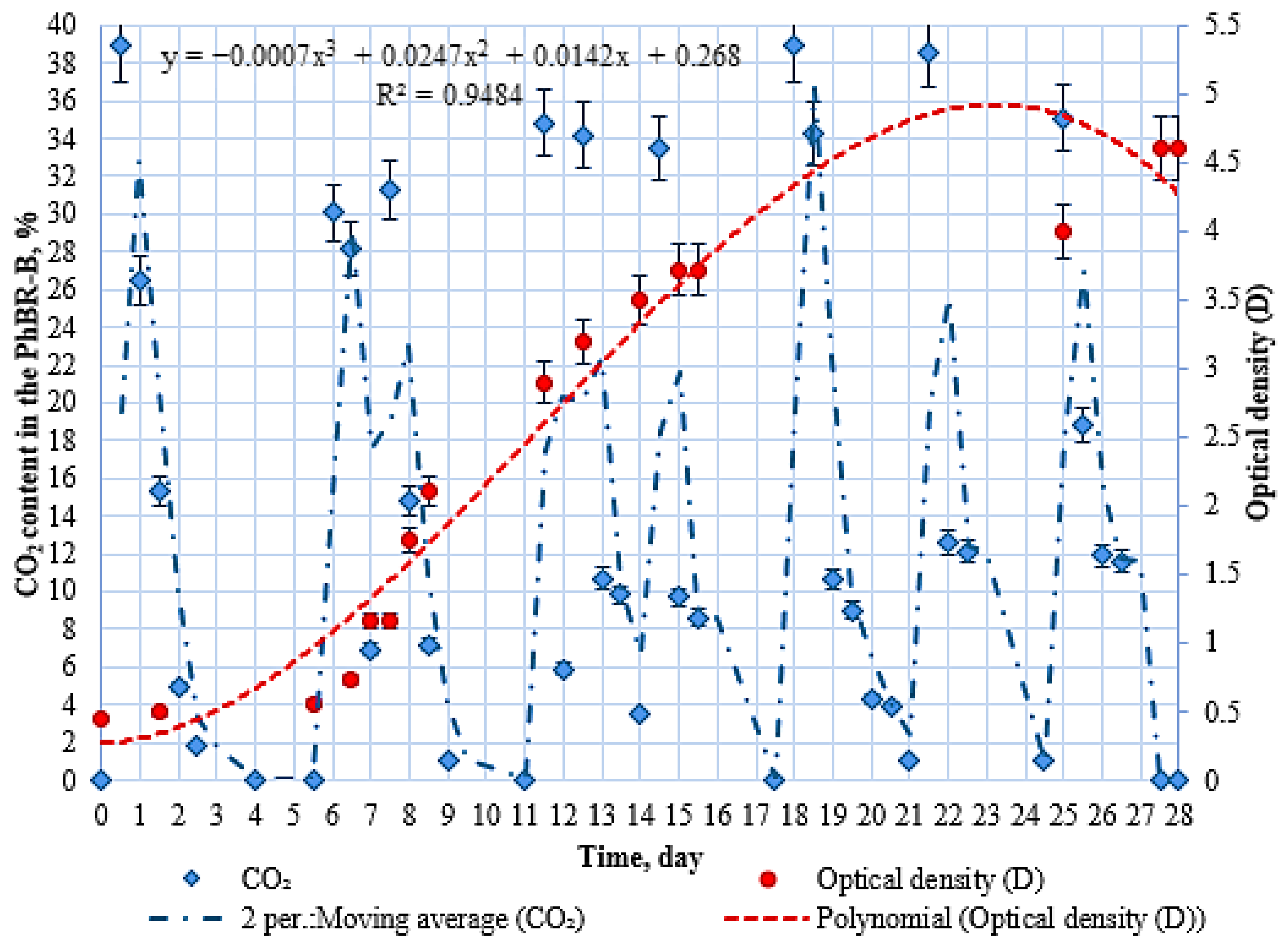

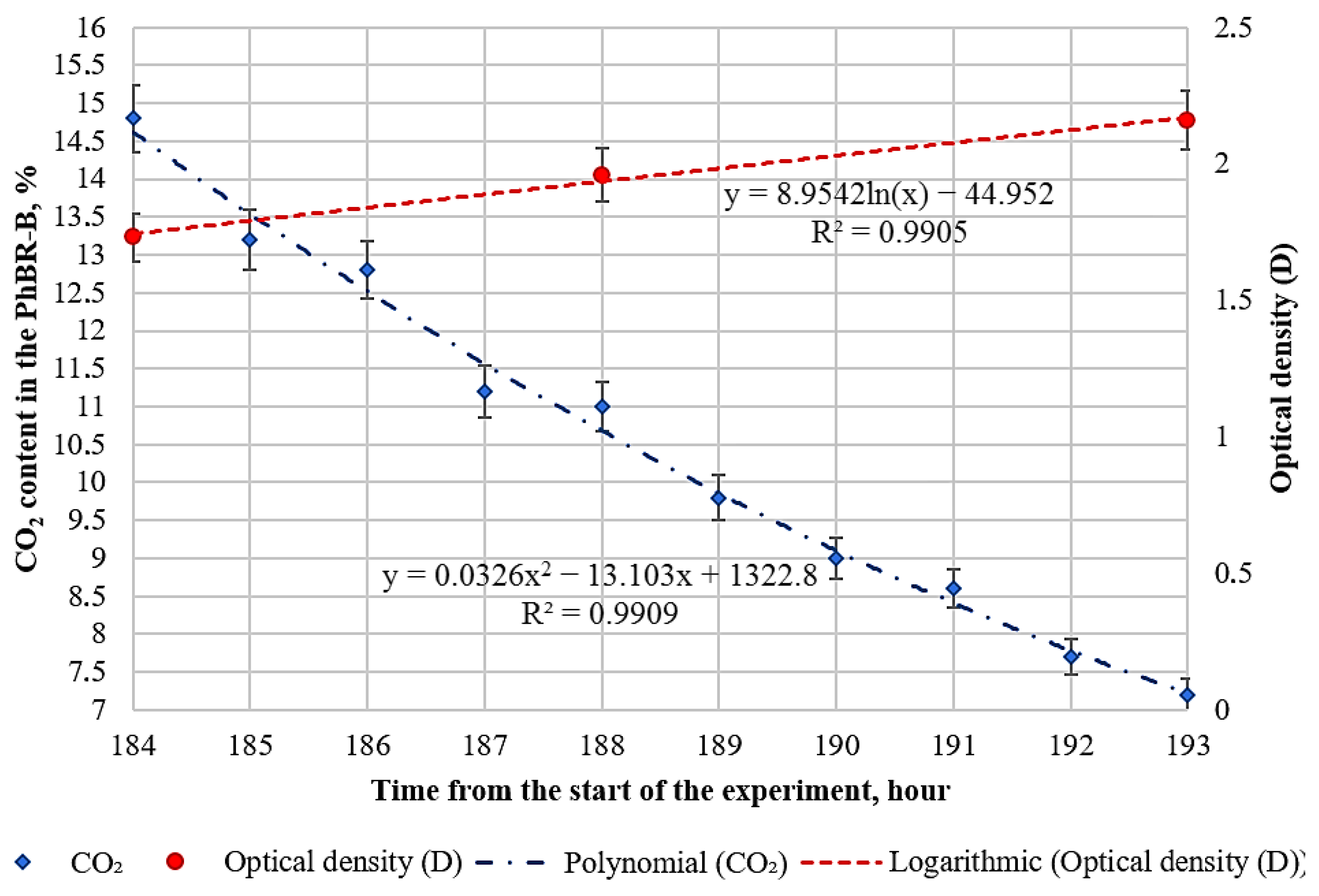
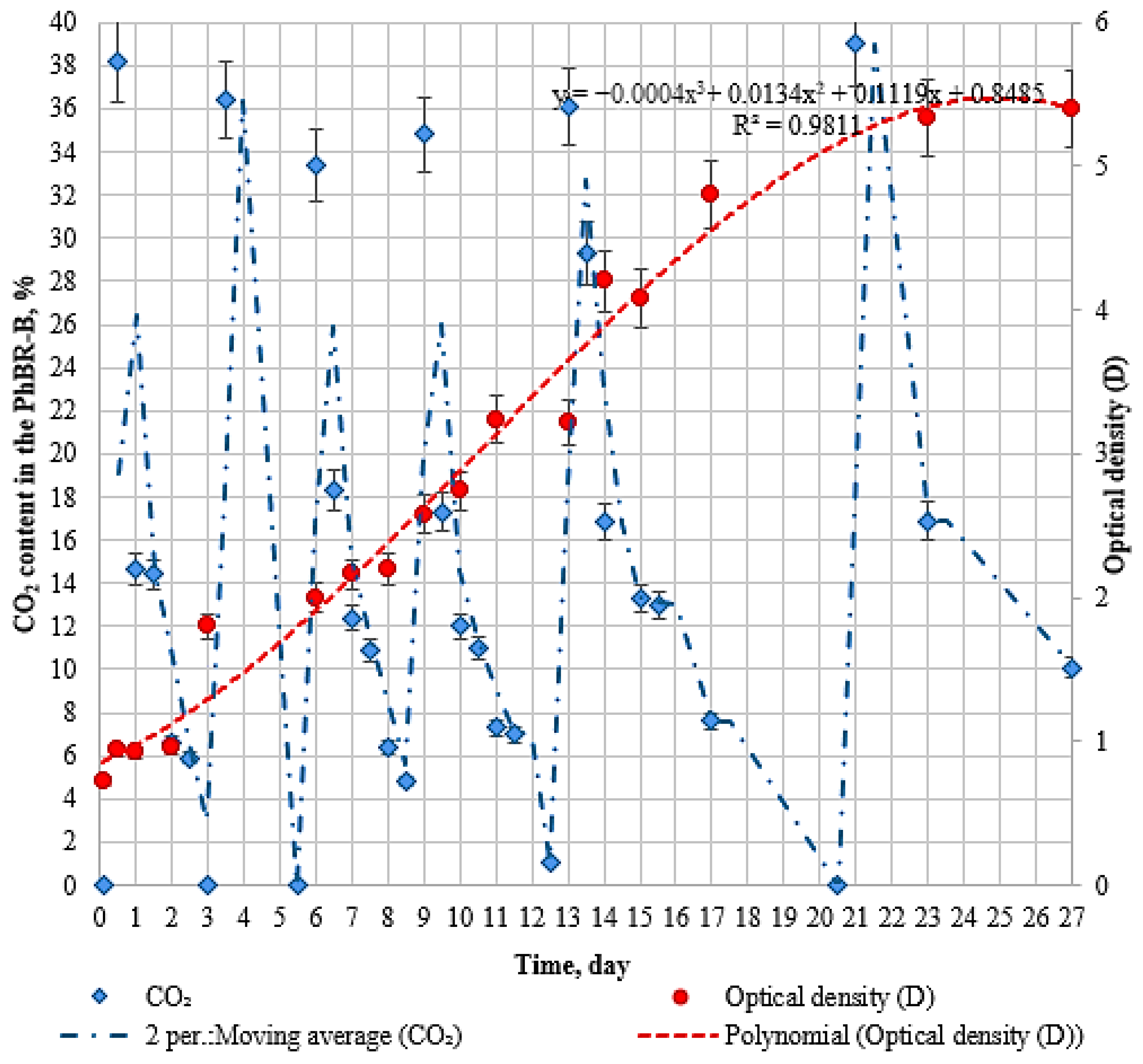
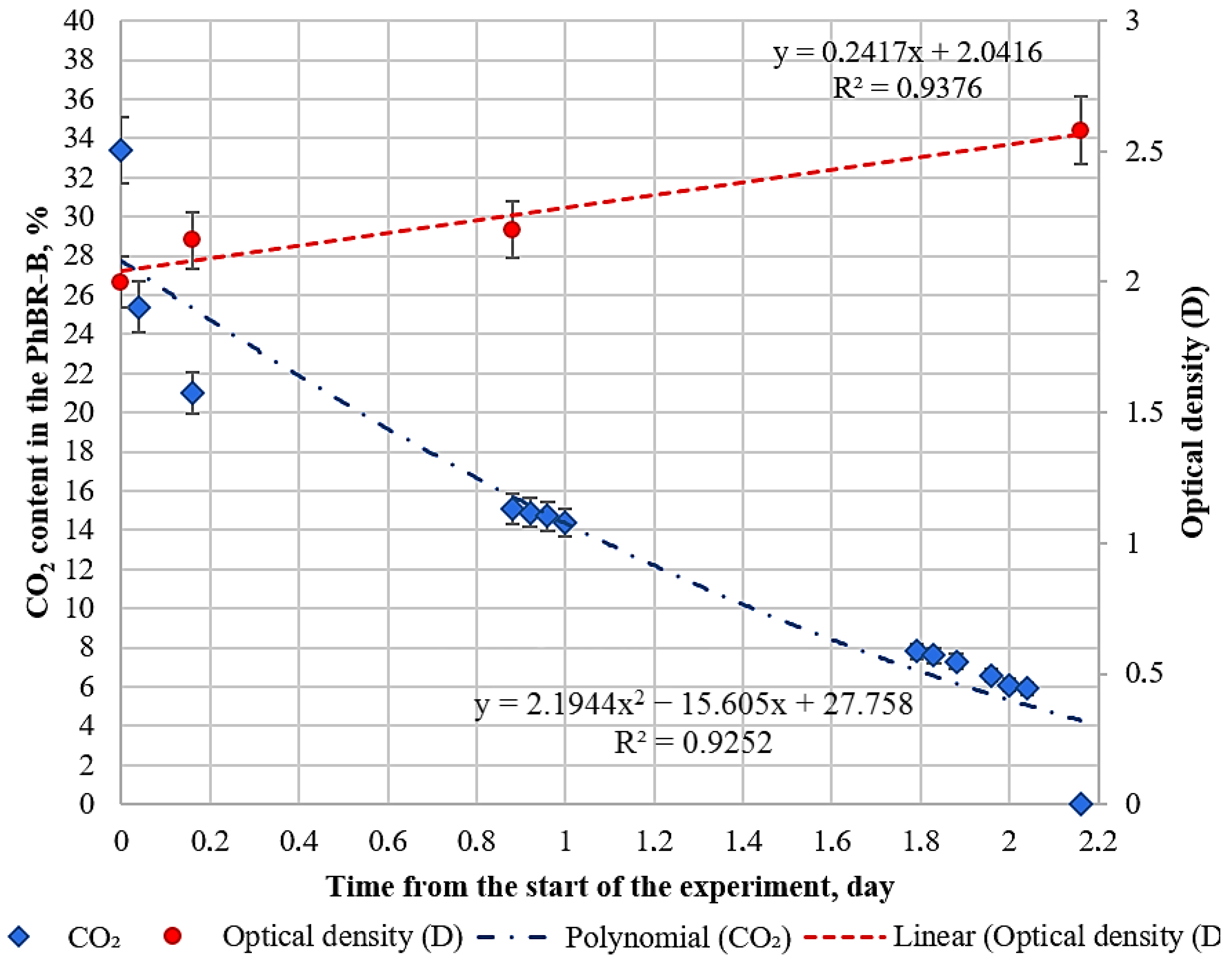

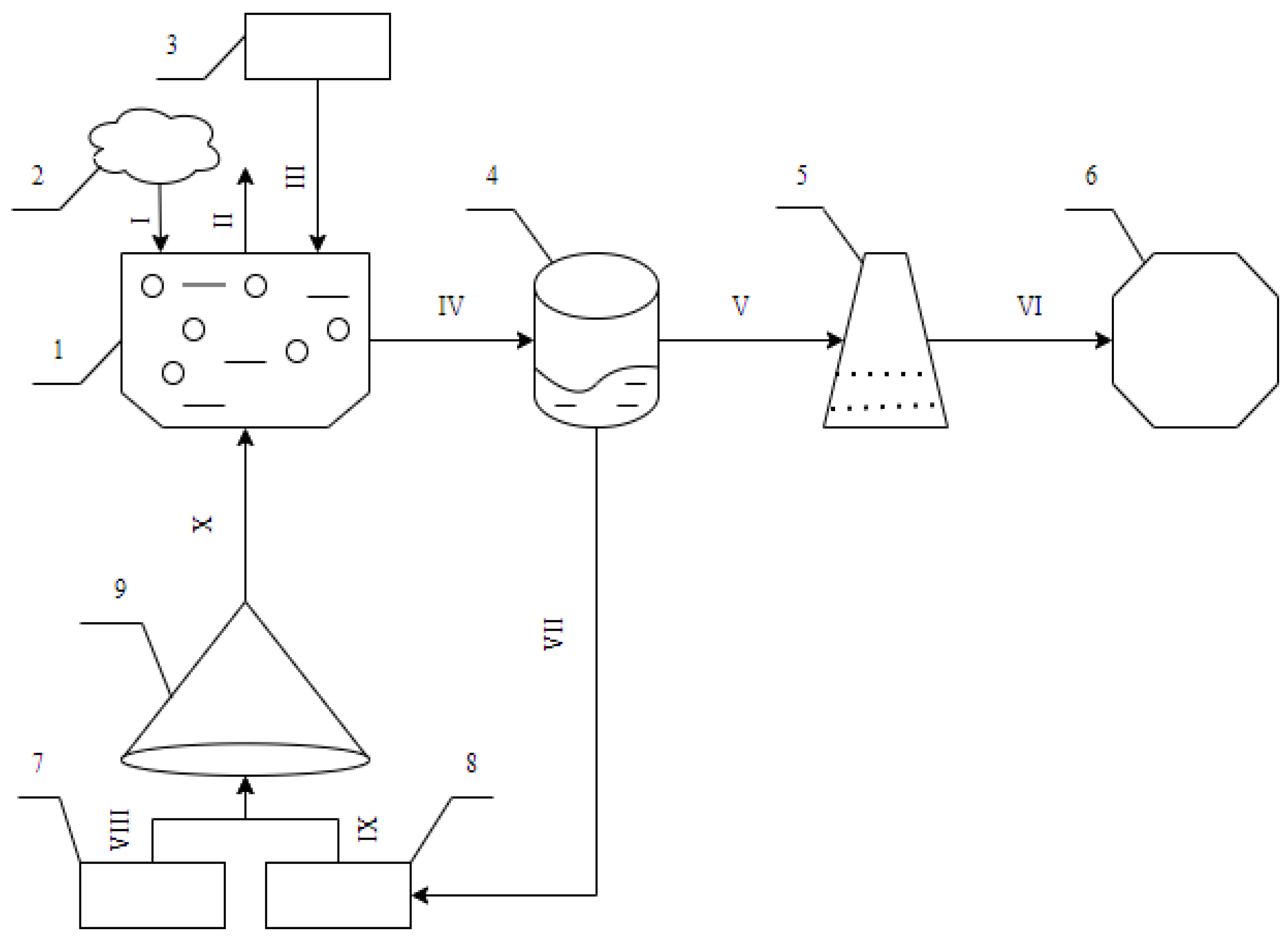
| Name of Substances | Concentration, mg/L |
|---|---|
| ZnSO4·7H2O | 100 |
| CuSO4·5H2O | 10 |
| CoSO4·7H2O | 100 |
| MnCl2·4H2O | 500 |
| H3BO3·WF | 50 |
| Na2MoO4·2H2O | 100 |
| FeCl3·6H2O | 4000 |
| Na2EDTA·2H2O | 6000 |
| KNO3 | 3.03 |
| KH2PO4 | 0.32 |
| MgSO4·7H2O | 2.4 |
| Factors | Sample No. 1 | Sample No. 2 | Sample No. 3 | Sample No. 4 | Sample No. 5 | Sample No. 6 |
|---|---|---|---|---|---|---|
| Temperature, °C | 25 | 25 | 25 | 30 | 30 | 30 |
| Illumination (daylight lamp), Lux | 2500 | 2500 | 2500 | 3000 | 3000 | 3000 |
| The volume of supplied CO2, L/% | 15.5/31 | 15.5/31 | 15.5/31 | 19.5/39 | 19.5/39 | 19.5/39 |
| Optical density on the 1st day, D * | 0.481 | 0.449 | 0.720 | 0.481 | 0.449 | 0.720 |
| Factors | Sample No. 1 | Sample No. 2 | Sample No. 3 | Sample No. 4 | Sample No. 5 | Sample No. 6 |
|---|---|---|---|---|---|---|
| The volume of supplied CO2, L/% | 15.5/31 | 15.5/31 | 15.5/31 | 19.5/39 | 19.5/39 | 19.5/39 |
| CO2 utilization time, days | 2.8 | 2 | 3 | 5 | 2.4 | 4 |
| Volume of CO2 utilized in 1 day by microalgae suspension, L * | 5.500 | 7.500 | 5.100 | 3.900 | 8.125 | 4.875 |
| CO2 uptake rate, g·L−1·day−1 | 0.195 | 0.225 | 0.225 | 0.154 | 0.412 | 0.192 |
| Optical density on the 1st day, D ** | 0.481 | 0.449 | 0.720 | 0.481 | 0.449 | 0.720 |
| Optical density on the 27th day, D ** | 5.580 | 4.631 | 5.340 | 5.061 | 4.369 | 5.011 |
Disclaimer/Publisher’s Note: The statements, opinions and data contained in all publications are solely those of the individual author(s) and contributor(s) and not of MDPI and/or the editor(s). MDPI and/or the editor(s) disclaim responsibility for any injury to people or property resulting from any ideas, methods, instructions or products referred to in the content. |
© 2023 by the authors. Licensee MDPI, Basel, Switzerland. This article is an open access article distributed under the terms and conditions of the Creative Commons Attribution (CC BY) license (https://creativecommons.org/licenses/by/4.0/).
Share and Cite
Politaeva, N.; Ilin, I.; Velmozhina, K.; Shinkevich, P. Carbon Dioxide Utilization Using Chlorella Microalgae. Environments 2023, 10, 109. https://doi.org/10.3390/environments10070109
Politaeva N, Ilin I, Velmozhina K, Shinkevich P. Carbon Dioxide Utilization Using Chlorella Microalgae. Environments. 2023; 10(7):109. https://doi.org/10.3390/environments10070109
Chicago/Turabian StylePolitaeva, Natalia, Igor Ilin, Ksenia Velmozhina, and Polina Shinkevich. 2023. "Carbon Dioxide Utilization Using Chlorella Microalgae" Environments 10, no. 7: 109. https://doi.org/10.3390/environments10070109






